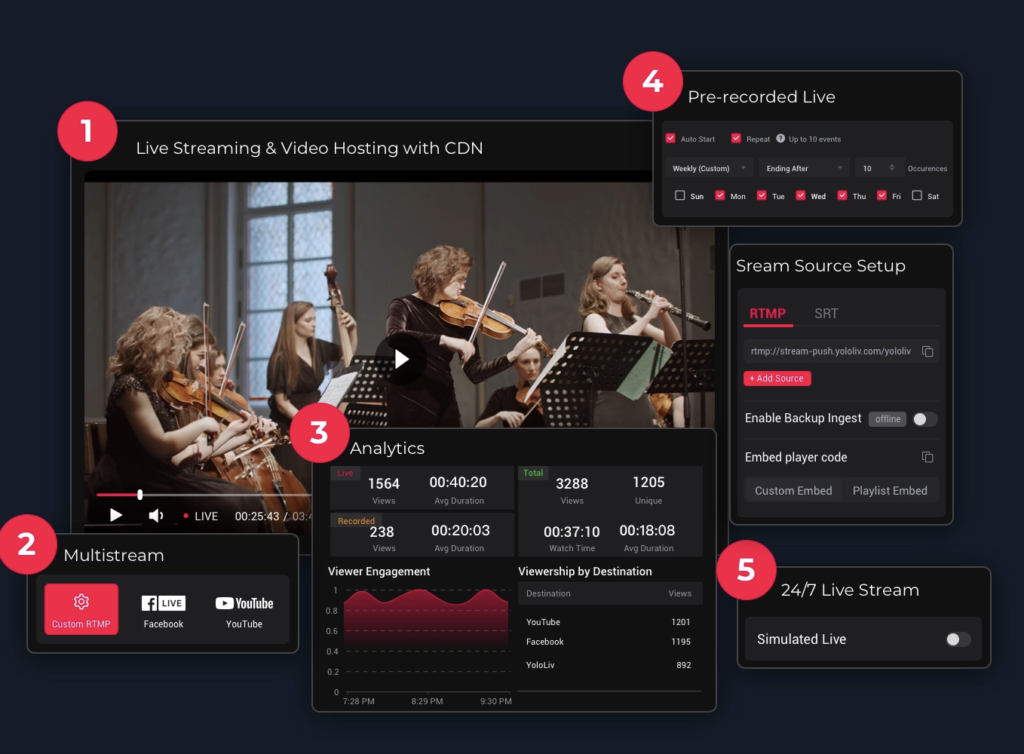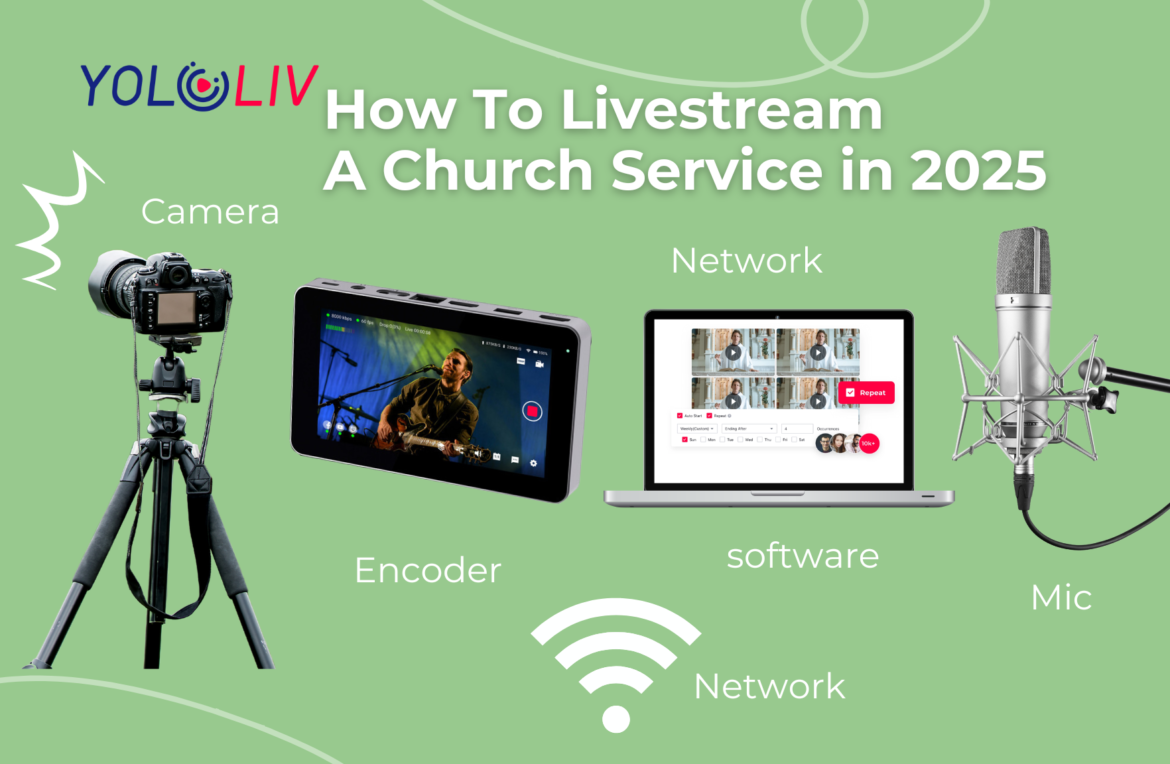Churches everywhere are discovering the power of live streaming to connect with their communities in meaningful ways. What started as a temporary measure has now become a crucial tool for modern ministry. Whether you’re leading a small rural congregation or a megachurch with multiple campuses, streaming your services online allows you to reach more people, more effectively, and with a personal touch. This guide will walk you through everything you need to know about live streaming your worship services in 2025—from understanding its importance to choosing the best platforms and getting started.
Why Livestream Church Services (Key Benefits)
Expanding Your Congregation Beyond Walls
The days when a church’s reach was limited to the people who could physically attend services are behind us. Live streaming opens up your church to the world. A member’s cousin in another state, or a traveler watching from an airport lounge—this is now possible. The internet transforms your church into a global sanctuary. Churches that stream regularly often see significant growth in their following—not just locally, but globally. No longer confined by zip codes, your church can reach people who are eager for hope and spiritual connection, just one click away.
Accessibility for All – Elderly, Sick, and Distant Members
One of the most impactful aspects of live streaming is accessibility. Elderly churchgoers, those recovering from illness, or members who’ve moved away can still remain a part of the congregation. For many, watching the Sunday service online is a vital spiritual lifeline. Whether they’re confined to their home, a hospital bed, or a retirement community, they don’t have to miss a sermon or a hymn. Church live streaming ensures that everyone stays connected, no matter the physical limitations. This is true inclusivity—serving your flock wherever they are.
Digital Evangelism and Outreach
Let’s face it—today’s generation lives online. If your ministry isn’t visible in the digital space, it’s missing out on huge outreach opportunities. Every sermon you stream is an opportunity for someone to encounter the Gospel. It’s evangelism in the modern world. And with the ease of sharing content across social media, your congregation becomes your ambassadors. A single share on Facebook could lead to five new viewers—and perhaps even lives transformed. The digital pulpit is incredibly powerful—don’t underestimate it.
Archiving Sermons for Future Use
Think of your live streams as more than just a moment in time—they’re a resource for the future. Whether for Bible study groups, sermon archives, or personal reflection, recorded services offer immense value. They can be repurposed into devotionals, podcasts, or short snippets for marketing. Having an organized library of past services adds professionalism and continuity to your ministry. It communicates to new viewers, “We’ve been here, we’re consistent, and our message is worth hearing.‘’
Church Live Streaming Equipment and Setup
Essential Streaming Equipment Checklist
Before you dive into platforms and promotion, it’s important to make sure your setup is solid. A smooth, professional church live stream starts with the right equipment. Here’s what you’ll need to get started:
Stable Internet Connection:
A strong internet connection is the backbone of any live stream—especially for churches. A poor connection can result in buffering, low-quality video, or even dropped streams. If you’re using YoloBox, consider enabling YoloLiv’s Network Bonding feature, which combines multiple internet sources to create a more stable and reliable connection. It’s a game-changer for churches in rural areas or those with spotty Wi-Fi. Click here to learn more.
Camera
The camera you choose will shape the entire visual experience of your live stream. Whether you’re working with a simple webcam or a professional-grade DSLR, your choice should reflect the style of worship you plan to stream and your available budget. For higher quality, cameras like DSLRs or camcorders offer better image clarity, zoom capabilities, and low-light performance—perfect for capturing meaningful worship moments. Look for ease of use, sharp resolution, and smooth zoom to deliver the best viewer experience.
Sturdy Tripod
Don’t overlook the importance of a reliable tripod. A shaky camera can be distracting during a sermon. A solid, adjustable tripod will keep your shots steady and help you maintain a consistent angle, whether you’re streaming from the front pew or the back of the sanctuary.
Microphones for Crisp Audio
In live streaming, good audio is just as important as good video—if not more. The spoken word is central to worship, so investing in the right microphone is essential. Wireless mic systems are a great choice for churches, offering flexibility without messy cords or tripping hazards. The best ones provide clear sound, long battery life, and strong coverage throughout your worship space.
Lighting
Good lighting makes a big difference, especially in dim or naturally lit sanctuaries. Soft, well-placed lighting ensures your subjects are visible and your stream looks polished. You don’t need a full studio setup—just enough to keep faces clear and shadows to a minimum.
Encoder
If you’re looking for a dedicated, all-in-one solution tailored for churches, both the YoloBox Ultra and YoloBox Extreme are top-tier options. These devices combine video switching, streaming, and recording in a single piece of hardware. They’re built for ease of use and ideal for ministries of all sizes.
Computer or Laptop
This will be the command center for your stream. Depending on your setup, it may handle everything from encoding to running software and managing overlays.
Church Streaming Software
Finally, you’ll need software that ties it all together. From scheduling and multistreaming to website embedding, the right platform makes a world of difference. That’s where YoloCast comes in—your complete church streaming solution designed to simplify your workflow and elevate your broadcast.
How to Livestream a Church Service:
Step 1: Choose a Streaming Platform

Start by picking a reliable platform to host your livestream. If you’re looking for something that’s powerful yet easy to use, YoloCast is a great option. It’s built for churches, schools, and organizations that want professional-level streaming without needing a full production team. With features like multistreaming, video embedding, analytics, and automated scheduling, YoloCast takes care of everything—all in the cloud.
Step 2: Obtain the Necessary Equipment
You don’t need a fancy studio setup to stream effectively. Start with a good quality camera, a microphone, a tripod, and if needed, an encoder (like YoloBox or any RTMP-enabled device). These tools help deliver clear video and audio so your message comes through loud and clear.
Step 3: Set Up Your Internet Connection
A stable internet connection is key. Aim for at least 5–10 Mbps upload speed for smooth streaming. Wired Ethernet is preferred over Wi-Fi to avoid dropouts. If your church has spotty internet, consider a mobile hotspot or bonded connection as a backup.
Step 4: Connect the Camera and Microphone
Plug your camera and mic into your encoder or directly into your computer. Make sure your audio and video sources are recognized. If you’re using a YoloBox, it simplifies this step with multiple inputs and a touchscreen interface.
Step 5: Install Streaming Software
If you’ve chosen YoloCast, great news—you don’t need to download or install anything. YoloCast is a cloud-based all-in-one platform, so you can just open it in your browser on any PC. It handles everything from stream management to storage automatically. All your recorded services are saved in the cloud for easy editing and sharing later.
Step 6: Input Audio and Video
Inside your streaming platform, make sure your audio and video inputs are correctly selected. Test your microphone levels and camera angle. You want your pastor to be clearly seen and heard—this helps your audience stay focused and engaged.
Step 7: Log Into Your Chosen Platform
Head to YoloCast.com and log in.
Create a new Event
Connect your video source using RTMP
Choose your destination platforms (like Facebook, YouTube, or your church website)
Or simply copy the YoloCast embed code to insert the player into your site—clean and professional!
Step 8: Conduct a Test Stream
Before the actual service, always run a private test. Check for audio sync, video clarity, and stream stability. This step can help you catch issues early and go live with confidence.
Step 9: Promote Your Live Stream in Advance
Let your community know when and where they can tune in. Post on Facebook, Instagram, your church website, and send out email reminders. You can even create teaser clips or countdown graphics using past footage.
Step 10: Start Streaming Early
Go live at least 10–15 minutes early. This gives viewers time to join in and lets you troubleshoot if something unexpected happens. Use this time to display a welcome message, background music, or a slideshow of announcements.
Step 11: Monitor and Engage With Your Online Audience
Assign someone to monitor the stream and chat. Greet viewers by name, answer questions, and encourage prayer requests. This makes online members feel just as connected as those sitting in the pews.
Step 12: End the Stream
Once the service wraps up, end your stream smoothly. Thank your online viewers for joining and let them know how to stay connected. YoloCast automatically stores your stream in the cloud, so you can edit, trim, or re-share it anytime.
YoloCast vs BoxCast / Dacast / Castr: What Makes YoloCast Stand Out?
At YoloLiv, we believe that churches shouldn’t have to choose between affordability and quality. That’s why we built YoloCast—a powerful, budget-friendly livestreaming solution designed specifically with churches in mind.
YoloCast covers virtually all the core features you’ll find in platforms like BoxCast, Dacast, and Castr—but at a fraction of the price.
Take our Exclusive Plan, for example: only $39/month, and it includes everything a church needs to stream professionally:
- Multistream to up to 30 platforms at once
- Website embedding (no extra charge)
- Automated scheduling for hands-free streaming
- Simulated live events using pre-recorded content
- Cloud storage and easy video management
By comparison, platforms like BoxCast offer website embedding only on their Advanced plans—and those can run you upwards of $189/month or more. Other platforms, like Dacast and Castr, quickly add up with extra fees for storage, multistreaming, or simulcasting.
With YoloCast, you get everything you need, minus the bloated pricing. More features. Less cost. Simple as that.
Conclusion: Bringing Church into the Digital Age
Livestreaming your church service isn’t just a modern convenience—it’s a mission field. In 2025, it’s one of the most effective ways to stay connected, grow your congregation, and share the message of faith and hope beyond your four walls.
Whether you’re broadcasting from a majestic cathedral or a small country chapel, your service has the power to reach hearts across neighborhoods, time zones, and even continents. With the right gear, a little planning, and the right platform—like YoloCast—you’re equipped to deliver more than just a broadcast. You’re creating a digital sanctuary.
Because every stream is a chance to inspire.
Every viewer is a soul reached.
And every interaction is a step toward deeper connection.
Let’s not just go live. Let’s go further. Let’s serve, connect, and grow—together.
905 total views, 87 views today

Hailey, a Customer Success Specialist at Yololiv, she brings immense enthusiasm to assisting users in understanding the various features of YoloCast and resolving any usage-related issues they may encounter. Alongside her support efforts, she also curates articles sharing tips, troubleshooting advice, and other helpful insights to enhance users’ experience with YoloCast.


